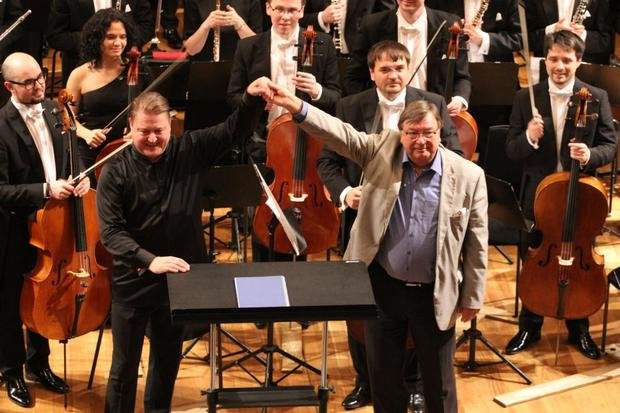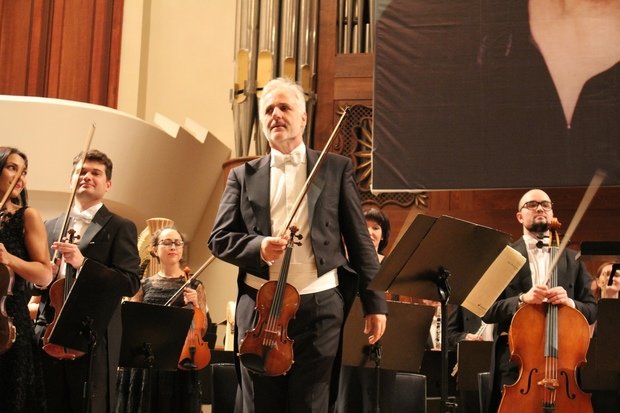Petrushka visits Concordia festival
The 8 th Concordia International Contemporary Music Festival named after Sofia Gubaidulina ended in Kazan. Its programme almost completely consisted of the first performances of compositions in Kazan and world premieres. The final concert, which traditionally was held in the full Salikh Saydashev State Big Concert Hall, reminded the audience of Dyagilev's Russian Seasons. Realnoe Vremya tells the details.
All to the garden!
Composer Aleksandr Tchaikovsky and the Tatarstan State Symphony Orchestra became twins, so to speak. Tchaikovsky's Tamerlan's Stature is one of the distinctive features of the Tatarstan symphony orchestra in the world. It's traditionally performed as an encore at the end of concerts, and an expressive music wave fills the hall causing amazed shouts of ''Bravo''. This is why the appearance of Aleksandr Tchaikovsky Garden Symphony, which is a new composition to citizens of Kazan, at Concordia is quite logical.
Garden Symphony, written for symphony orchestra and an ensemble of folk instruments and performed at 2018 Concordia's final concert, continued the series of the first performances of compositions, which has been one of the basic points in the repertoire politics of the Tatarstan State Symphony Orchestra. The composer created it in 2013 and dedicated it to Mariss Jansons. The composition was first performed a year after its creation, the premiere was in Munich and transmitted throughout Germany. Initially, this composition was created by the composer as an order of the Bavarian Radio Symphony Orchestra.

Aleksandr Tchaikovsky's symphony is an ironic composition, and Aleksandr Sladkovsky felt this irony, even some mockery, well. The foundation of Garden Symphony – Bavarian waltz, and it seems to be incompatible – is a music material from the ''small opera'' based on Pushkin's fairy tale Tsar Nikita and His Forty Daughters. The maestro led the orchestra elegantly, easily and merrily inspiring both the musicians and the hall with his lightness. After the symphony was performed, the author, Aleksandr Tchaikovsky, who was present in the hall stepped on the stage.
Dolls also cry
Most part of the concert was dedicated to Igor Stravinsky's music, which somehow created a kind of arch from our festival to Sergey Dyagilev's Russian Seasons when the audience acquainted with the best samples of contemporary music in the same way. Dyagilev was not only a genius producer but also an educator who promoted Russian art in Europe. In this respect, the promotion of the Tatarstan State Symphony Orchestra as a Tatarstan musical brand to world stages is also similar to what the creator of Russian Seasons did.
The first part of the contemporary music festival's concert ended with a concert for violin and orchestra with Vienna Philharmonic Orchestra concertmaster Rainer Honeck playing a Stradivarius violin as a soloist. The invitation of the musician of this level to Kazan is worth mentioning him. Honeck, naturally, demonstrated a virtuoso play when performing Igor Stravinsky's complicated concert, while maestro Sladkovsky illustrated again how delicately he could work with a soloist and how finely and deeply the orchestra conducted by him could sink into the elegance of too complicated music.

The second part was given to Stravinsky's Petrushka ballet. How finely the head conductor of the Tatarstan State Symphony Orchestra felt the nature of Stravinsky's tragicomic ballet! Petrushka, whose premiere was in Châtelet in Paris during Russian Seasons where both the fracture, which is characteristic of the Silver Age and popular chaos, humour of popular doll performances and the drama of unrequited love, became a kind of personal expression of the maestro.
Petrushka by Aleksandr Sladkovsky is a tragicomedy with an accent on the first syllabus of the word. The main character of the ballet, straw-made Petrushka, a merry fellow, who loves Ballerina is betrayed. The little person who suffered from a fiasco, the stalled laughing mask on his face is a mask of grief. Sladkovsky reminded us of these tears the world doesn't see, which are sad because one has to force laughter.
One shouldn't have guessed what the final concert of Concordia would end with in 2018. Of course, with Tamerlan's Stature performed with special inspiration because the author was in the hall.